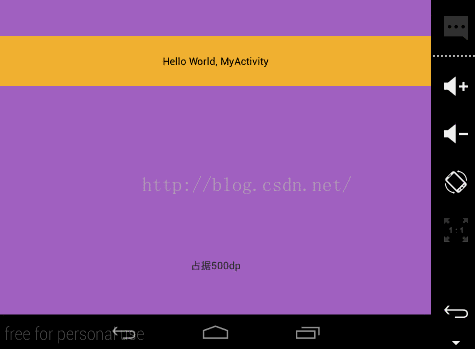android popupwindow用法详解
人气:0一、基本用法
一般做法,新建类继承popupwindow。例
/**
* popupwindow基本用法
* Created by Administrator on 2015/11/25.
*/
public class DemoBasePop extends PopupWindow {
private LinearLayout linear_layout;
private TextView dbp_text;
private Context context;
public DemoBasePop(final Activity context) {
super(context);
this.context = context;
View view = LayoutInflater.from(context).inflate(R.layout.demo_base_pop,null);
setContentView(view);
setWidth(ViewGroup.LayoutParams.MATCH_PARENT);
setHeight(200);
// setHeight(ViewGroup.LayoutParams.MATCH_PARENT);
setFocusable(true);
setBackgroundDrawable(new BitmapDrawable());
setTouchable(true);
setOutsideTouchable(true);
setAnimationStyle(R.style.popwin_anim_style);
// setAnimationStyle(0); 0是没有animation
initView(view);
}
private void initView(View view) {
dbp_text = (TextView) view.findViewById(R.id.dbp_text);
}
}
研究下popupwindow源码,以showAsDropDown来讲
public void showAsDropDown(View anchor, int xoff, int yoff) {
if (isShowing() || mContentView == null) {
return;
}
registerForScrollChanged(anchor, xoff, yoff);
mIsShowing = true;
mIsDropdown = true;
WindowManager.LayoutParams p = createPopupLayout(anchor.getWindowToken());
preparePopup(p);
updateAboveAnchor(findDropDownPosition(anchor, p, xoff, yoff));
if (mHeightMode < 0) p.height = mLastHeight = mHeightMode;
if (mWidthMode < 0) p.width = mLastWidth = mWidthMode;
p.windowAnimations = computeAnimationResource();
invokePopup(p);
}
第11行创建WindowManager.LayoutParams。第12行preparePopup()中:
if (mBackground != null) {
final ViewGroup.LayoutParams layoutParams = mContentView.getLayoutParams();
int height = ViewGroup.LayoutParams.MATCH_PARENT;
if (layoutParams != null &&
layoutParams.height == ViewGroup.LayoutParams.WRAP_CONTENT) {
height = ViewGroup.LayoutParams.WRAP_CONTENT;
}
// when a background is available, we embed the content view
// within another view that owns the background drawable
PopupViewContainer popupViewContainer = new PopupViewContainer(mContext);
PopupViewContainer.LayoutParams listParams = new PopupViewContainer.LayoutParams(
ViewGroup.LayoutParams.MATCH_PARENT, height
);
popupViewContainer.setBackgroundDrawable(mBackground);
popupViewContainer.addView(mContentView, listParams);
mPopupView = popupViewContainer;
} else {
mPopupView = mContentView;
}
如果做了setBackgroundDrawable(new BitmapDrawable());那么mBackground则不为空,则会用PopupViewContainer作为mPopupView(即内容view)。而PopupViewContainer的dispatchKeyEvent对返回键做了处理,按返回键后其中调用dismiss()方法。其onTouchEvent对触摸事件做了处理,其源码:
public boolean onTouchEvent(MotionEvent event) {
final int x = (int) event.getX();
final int y = (int) event.getY();
<span style="font-family: 宋体; font-size: 9pt;">//点击外部隐藏</span>
if ((event.getAction() == MotionEvent.ACTION_DOWN)
&& ((x < 0) || (x >= getWidth()) || (y < 0) || (y >= getHeight()))) {
dismiss();
return true;
} else if (event.getAction() == MotionEvent.ACTION_OUTSIDE) {
dismiss();
return true;
} else {
return super.onTouchEvent(event);
}
}
系统做了这些处理,随之而来一个问题,如果我们要监听物理返回键该怎么办。看了上面的过程,我们可以想到将
setBackgroundDrawable(null);然后通过设置view的key监听,监听到后做相应的处理。
view.setOnKeyListener(new View.OnKeyListener() {
@Override
public boolean onKey(View v, int keyCode, KeyEvent event) {
if (event.getKeyCode() == KeyEvent.KEYCODE_BACK) {
if (event.getAction() == KeyEvent.ACTION_DOWN
&& event.getRepeatCount() == 0) {
outAnimator.start();
return true;
}
}
return false;
}
});
效果图:

您可能感兴趣的文章:
- android PopupWindow 和 Activity弹出窗口实现方式
- android popwindow实现左侧弹出菜单层及PopupWindow主要方法介绍
- Android Animation实战之屏幕底部弹出PopupWindow
- Android编程实现popupwindow弹出后屏幕背景变成半透明效果
- Android入门之PopupWindow用法实例解析
- Android实现底部弹出PopupWindow背景逐渐变暗效果
- Android之用PopupWindow实现弹出菜单的方法详解
- Android中PopupWindow响应返回键并关闭的2种方法
- android使用PopupWindow实现页面点击顶部弹出下拉菜单
- android自定义popupwindow仿微信右上角弹出菜单效果
加载全部内容